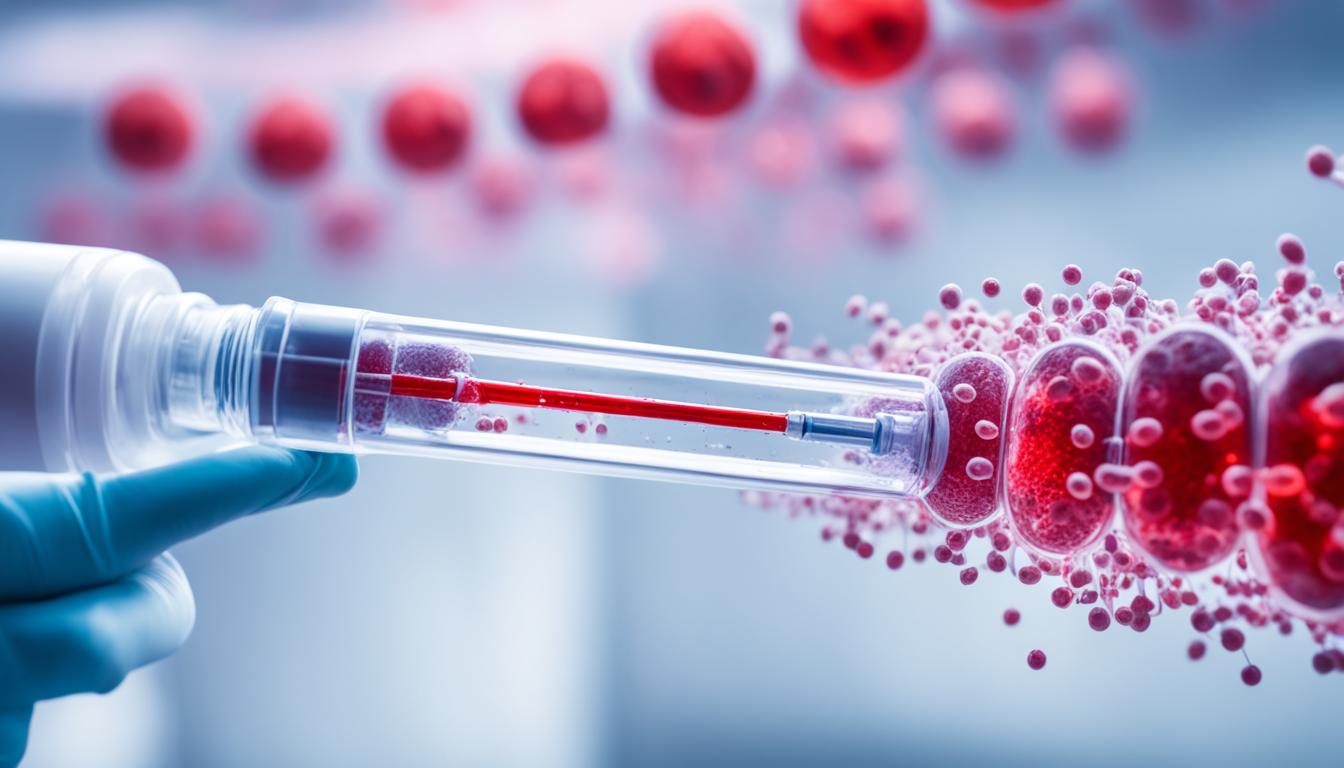Glucocerebrosidase deficiency, or Gaucher disease, is a rare issue caused by a gene mutation. This mutation leads to a harmful buildup of lipids in organs. It happens due to a lack of glucocerebrosidase, an enzyme that breaks down these lipids.
The signs of this disease can vary from mild to severe. People might experience a big liver and spleen, low blood cell counts, weak bones, and bone tissue death. These symptoms are common but not the same for everyone with the disease.
This condition is more frequent in the Ashkenazi Jewish community. Yet, it can affect anyone, no matter their background, making it a global issue.
Doctors check for Gaucher disease by doing blood tests and genetic tests. They might also look at images of the body, like X-rays and MRI scans, to see any unusual growths. Couples who might pass the disease to their children can get tested before pregnancy.
Unfortunately, there is no complete cure for Gaucher. But there are ways to manage its impact. Enzyme replacement therapy helps by giving back the missing enzyme. Stem cell transplants offer another path, aiming to replace the faulty cells.
Key Takeaways:
- Glucocerebrosidase deficiency, or Gaucher disease, is rare and leads to lipid buildup in the body.
- A lack of the glucocerebrosidase enzyme causes this, due to a gene mutation.
- People may see symptoms like organ growth, blood cell issues, and bone problems.
- Tests for Gaucher include blood work, genetic checks, and body images.
- Management methods focus on enzyme replacement and stem cell treatments.
- Stem cell therapy is promising, especially for type 1 Gaucher disease.
Types and Symptoms of Gaucher Disease
Gaucher disease has three main types: type 1, type 2, and type 3. Each has its own set of symptoms and effects. The severity varies depending on the type.
Type 1 Gaucher Disease
Type 1 Gaucher disease is the most common. It affects the blood, liver, and spleen. Common symptoms include anemia, thrombocytopenia, and organ enlargement.
- Anemia
- Thrombocytopenia (low platelet count)
- Hepatomegaly (enlarged liver)
- Splenomegaly (enlarged spleen)
- Osteoporosis (weak, brittle bones)
- Yellowish-brown skin pigmentation
Type 2 Gaucher Disease
Type 2 is rare and very severe. It affects the central nervous system. People with type 2 may have issues like poor development and seizures, in addition to common type 1 symptoms.
- Poor development
- Seizures
- Rigidity
- Difficulty sucking and swallowing
Type 3 Gaucher Disease
Type 3 is less severe than type 2 but serious. It includes some neurological symptoms. Besides standard type 1 symptoms, type 3 can lead to delayed cognitive development and dementia.
- Delayed cognitive development
- Seizures
- Dementia
It’s key to know the various Gaucher disease types and their symptoms. This knowledge helps doctors diagnose correctly and choose the best treatments. Identifying the type is critical for good medical care. Type 1 mainly affects certain organs. Type 2 is very serious, involving the nervous system. Type 3 is also severe but less than type 2, with added neurological issues. Each type has its unique impacts.
Causes and Diagnosis of Glucocerebrosidase Deficiency
Glucocerebrosidase deficiency or Gaucher disease comes from GBA1 gene mutations. These changes stop the glucocerebrosidase enzyme from working right. This enzyme normally helps break down certain fats inside cells.
It’s passed down when both parents carry a copy of the mutated gene. These carriers usually don’t show symptoms. However, it’s how they can give the disease to their children.
To spot Gaucher disease, doctors do tests on blood and genes. They look for low levels of glucocerebrosidase in the blood and check the GBA1 gene. They might also use X-rays and MRI to check for organ and bone problems, signs of the disease.
For parents at risk, there’s prenatal screening. It tests the baby’s DNA before birth. Finding gene mutations early lets parents make informed choices and get ready for any needed care after birth.
Diagnosis of Gaucher disease involves:
- Blood tests to measure glucocerebrosidase activity
- Genetic testing to identify mutations in the GBA1 gene
- Imaging studies (X-rays, MRI scans) to assess organ enlargement and bone abnormalities
- Prenatal screening for couples at risk of having a child with Gaucher disease
Spotting Gaucher disease early is key for the best care. By using tests and studying genes, doctors can make plans just for you. This helps manage the disease well.
Stem Cell Therapy for Glucocerebrosidase Deficiency
Stem cell therapy shows great promise for treating Gaucher disease, especially type 1. It involves putting healthy stem cells into the patient. Stem cells come from places like bone marrow and umbilical cord blood, giving more treatment choices.
Studies reveal stem cell therapy can help a lot. It can improve symptoms like having a big liver and spleen or blood problems. Stem cells bring hope for a better and longer lasting solution.
But, stem cell therapy isn’t for everyone with Gaucher disease. It needs careful thinking, like looking at how ill someone is, their age, and health. Talking to a specialist can help in deciding what’s best.
There are also other ways to treat Gaucher disease, like enzyme replacement therapy or cutting down on certain substances’ use. These methods work to ease symptoms and slow down the illness. With new discoveries in regenerative medicine, including stem cell therapy, there’s hope for a better life for those with Gaucher disease.

